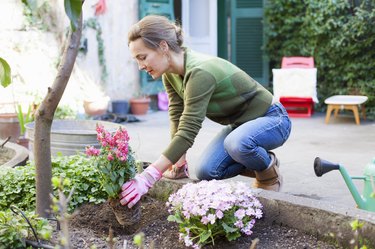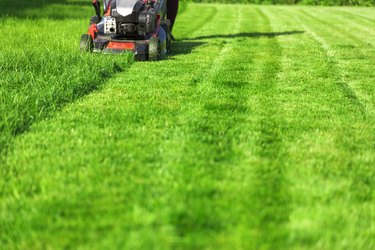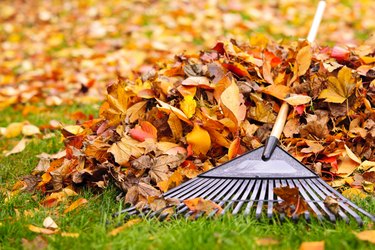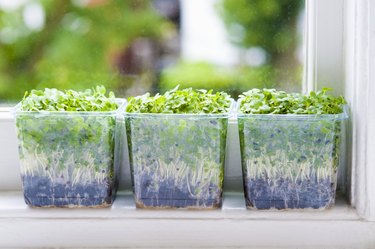
Gardening outdoors may not be an option if you have limited space or a short growing season. Enter "container gardening," where you sow seeds in containers rather than the ground. And using safe plastic planters for vegetables and other sprouts can help you make the most of your little garden.
So, why exactly is it important to know which plastics are safe for gardening? Well, it's possible for the chemicals in certain types of plastic to leach out, according to the University of New Hampshire.
Video of the Day
Video of the Day
That said, while it's typically better to grow food in the dirt and away from toxins, it is safe to grow vegetables in plastic containers so long as the planter is made of certain types of plastic approved for use with food. Here are the safest types of plastic tubs for gardening to help you get started.
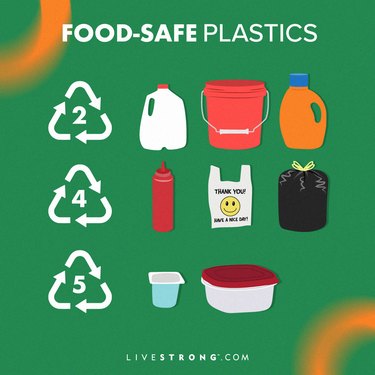
High-Density Polyethylene
High-density polyethylene (HDPE) is a type of food-safe plastic used in milk jugs, water bottles, trash bags and some buckets, according to the Environmental Protection Agency (EPA). You can identify HDPE by locating a triangle with the number 2 on the bottom of your container, per the EPA.
HDPE planters are typically considered safe containers for growing vegetables. What's more, HDPE is recommended as a type of food-safe plastic sheeting for garden beds that are made of treated wood, as this type of plastic can shield plants from the chemicals in the wood, according to Iowa State University.
However, if your garden is outside in your yard, it's important to remember that HDPE containers aren't typically made for outdoor use — exposure to the elements can break them down, so it may be wise to replace these planters often, according to the University of Maryland.
Low-Density Polyethylene
Low-density polyethylene (LDPE) is another common plastic also used to make milk jugs, water bottles and trash bags, according to the EPA. You can identify it by finding a triangle with the number 4 on the bottom of your container.
Similar to HDPE, this type of plastic can be used as sheeting to protect your plants from chemicals in treated wood, according to Iowa State University.
But you may have to replace them often, per the University of Maryland, as this type of plastic can break down.
Polypropylene
Polypropylene (PP) is a strong plastic often used to make caps and lids, denoted by the number 5 on the bottom of a product, according to the EPA.
PP has a high melting point and is approved for food contact, according to the U.S. Food and Drug Administration. And when it comes to growing plants in plastic containers, this type of plastic is also sometimes recommended as a cover to protect sprouts against elements like frost, per New Mexico State University.
PP fabric liners can also be used to protect plants from the chemicals in treated wood, according to Iowa State University.
Tip
Plant covers are typically only necessary if you're gardening outdoors, per New Mexico State University. Visit your local gardening store for advice if you're concerned about your plants' exposure to weather conditions.
Polylactic Acid
Polylactic acid (PLA) is a newer type of plastic derived from renewable resources like corn, wheat and rice, according to December 2016 research in Advanced Drug Delivery Reviews. It's most commonly used as a material for 3D printing.
But it may also make for a safe plastic planter for vegetables and other plants. That's because the material is bio-based and compostable, making it less of a concern for soil contamination.
Plastics to Avoid as Containers for Growing Food
Polyethylene Terephthalate
Polyethylene terephthalate (PET) is a clear, tough plastic mostly used in water, juice and soda bottles, identified by a number 1 on the bottom of a product, according to the EPA.
PET is considered safe for single use, but less safe as a reusable plastic container because it can release harmful chemicals like bisphenol A (BPA) over time, particularly when it's heated up, according to a September 2014 study in Environmental Pollution.
While this is more cause for concern if you're hoping to reuse plastic water bottles, it still may be best to opt to grow vegetables in plastic containers made from different types of the material.
- University of New Hampshire: "Growing Vegetables In Containers"
- Iowa State University: "Toxicity Concerns about Raised Bed Construction Materials"
- Environmental Protection Agency: "Containers and Packaging: Product-Specific Data"
- Environmental Protection Agency: "How Do I Recycle?: Common Recyclables"
- University of Maryland: "Types of Containers for Growing Vegetables"
- New Mexico State University: "Row Cover Vegetable Production Techniques"
- U.S. Food and Drug Administration: "CFR - Code of Federal Regulations Title 21"
- Environmental Pollution: "Effects of storage temperature and duration on release of antimony and bisphenol A from polyethylene terephthalate drinking water bottles of China"
- Advanced Drug Delivery Reviews: "Physical and mechanical properties of PLA, and their functions in widespread applications — A comprehensive review"
- Urban Organic Gardener
Is this an emergency? If you are experiencing serious medical symptoms, please see the National Library of Medicine’s list of signs you need emergency medical attention or call 911.
